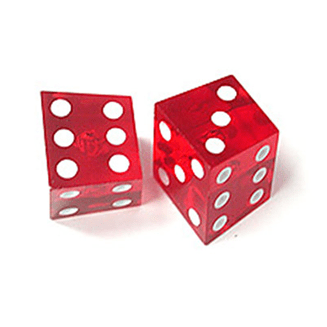
Have you heard of crooked dice? If you are playing at a reputable casino, you don’t have to worry about crooked dice that favor the casino. Generally, casinos are strictly controlled by government regulatory agencies and it’s not worth it to the casino to risk getting caught cheating its customers. Depending on the severity of the infraction, the casino could lose its operating license, which would cost the casino a lot more in profits than what they could make on a crooked table. But playing at play at unknown casino then you might have to worry about the host introducing crooked dice into the game.
Two Important Rules
Remember the two key dice-throwing rules that help you and the casino to prevent cheaters from using crooked dice.
- The shooter must handle the dice with only one hand. If a shooter brings both hands into play, the crew immediately in a strong voice reminds the player. When a player handles the dice with two hands, it’s usually because he’s new to the game and doesn’t know any better. Embarrassed, the player usually drops the dice onto the table and apologizes.
- Never bring the dice “outside the table.” Imagine a vertical plane going straight up from the outer edge of the table. The dice can never break that imaginary plane. This rule is occasionally broken typically when a newbie player picks up the dice correctly with one hand, but then gets distracted.
These two rules alone make it difficult for a cheat to succeed at switching straight dice for crooked ones. Some people are so skilled that they can make the switch without being noticed even with the casino’s strict dice-throwing rules. The casino is protected from these highly skilled cheats by the mirror that covers the entire length of the table wall opposite the boxman. When a cheat uses the back of his hand to hide the switch from the boxman’s perspective, his palm is exposed to the mirror. The boxman simply looks at the mirror to observe what’s happening in the shooter’s palm.
The role of Boxman
When a dice bounces off the craps table because of the shooter’s poor roll, the boxman thoroughly inspects it before allowing it to come back into play. The boxman first visually inspects it for obvious signs of irregularity. He then checks the serial number imprinted on it to ensure it matches one of the designated serial numbers for that shift at that time of day (dice are replaced at random times every 24 hours or less). For example, if the serial number for that particular shift is “345” and the boxman sees that the serial number on the dice is “678,” then he removes the dice from play and informs the pit boss who then makes a note of it for a later investigation into how a nonconforming serial number got into the game. The last thing the boxman does as part of his routine inspection is hold the dice at the corners with his thumb and index finger and then twirl it to feel the balance. If it feels the slightest bit off balance, the boxman removes it from the game.
Types of Crooked Dice

There are many types of crooked dice. The most common are floaters, shapes, bricks, capped, painted, and loaded. “Floaters” have an off-center hole inside them and float in water. “Shapes” are dice that have rounded edges or points, or aren’t perfect cubes (i.e., one or more slightly concave or convex sides). (Legitimate craps dice are unlike dice that come with board games such as Monopoly. Craps dice are perfect cubes with sharp edges and points.) “Bricks” are also known as “flats” and have one side cut off just a hair to make the adjacent sides smaller. A “capped” dice has one or more of its sides shaved a bit with the side(s) rebuilt back to a perfect cube with material that has different bounce properties. “Painted” dice have any of a variety of transparent material applied to one or more sides to make it stickier or slicker than the other sides. “Loaded” dice are weighted so one side is heavier that the others (e.g., the pips on the “6” side of the dice are painted with a heavy material that makes that side just a hair heavier than the others).
Superior kind of loaded and electric dice
They are made by drilling out two adjacent spots or pips at one edge of the die, filling in the cavity with mercury, and cementing it up fast. Electric dice are made of celluloid. The first operation in making dice of this kind is to bore out a cylindrical cavity almost completely through the die, the mouth of this cavity being situated upon the face of the dice which will bear the six pips, and the bottom almost reaching to the opposite face, upon which is the ace.
At the bottom of the cavity, and consequently immediately within the dice above the single pip or ace, is put a thin circular disc of iron. The greater part of the cavity is then filled in with cork, leaving sufficient depth for the insertion of a plug, which effectually closes up the aperture, and upon the outer side of which are marked the six pips appertaining to that face of the die. Before this plug is fastened into its place, however, a small pellet of lead, of exactly the same weight as the iron disc, is pressed into the upper surface of the cork, and there fixed. Finally, the plug bearing the six pips is cemented into its place, and the die is complete. Apparently, this plug is cemented in with celluloid, the same material as that used in fabricating the dice itself, and the joint is so well and neatly made that it is invisible, even though examined with a powerful lens.
The rationale of this construction is as follows. The iron disc and the leaden pellet, being immediately within opposite faces of the dice, will exactly balance each other, and thus the die can be spun or thrown in exactly the same manner as a genuine one. The lead and iron, however, being so much heavier than the material of which the body of the dice is supposed to consist, would cause the weight of the dice to be very suspicious, were it not for the fact that the interior is almost entirely composed of a still lighter material — cork. Therefore, the completed dice is no heavier than a genuine one of the same size and appearance. In fact, these dice will bear the strictest examination, in every way — except one, viz. the application of a magnet. The word magnet gives the key to the employment of these so-called electric dice.
All of these techniques of modifying the dice have one common purpose, which is to only very slightly change the chances of selected numbers appearing. If the player knows there’s a slightly better chance that one or more numbers might appear, then that slight chance can be enough to adjust a small house advantage to a small player advantage.
With all the safeguards the legitimate casino has in-place nowadays, cheating by using crooked dice isn’t worth the risk of getting caught. Even if the cheat can gain a small advantage, it requires a long time to accumulate enough winnings to make the risk worth it. Do not worry about someone introducing crooked dice at a live table in a legitimate casino. Such cheaters won’t last long and also have no better practice of their own.
